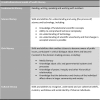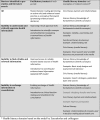Development of a complex intervention to improve health literacy skills
- PMID: 24251890
- PMCID: PMC4383652
- DOI: 10.1111/hir.12037
Development of a complex intervention to improve health literacy skills
Abstract
Background: Providing insight into the developmental processes involved in building interventions is an important way to ensure methodological transparency and inform future research efforts. The objective of this study was to describe the development of a web portal designed to improve health literacy skills among the public.
Methods: The web portal was tailored to address three key barriers to obtaining information, using the conceptual frameworks of shared decision-making and evidence-based practice and based on explicit criteria for selecting the content and form of the intervention.
Results: The web portal targeted the general public and took the form of structured sets of tools. Content included: an introduction to research methods, help on how to find evidence-based health information efficiently based on the steps of evidence-based practice, an introduction to critical appraisal, information about patient participation rights in decision-making, and a decision aid for consultations.
Conclusions: The web portal was designed in a systematic and transparent way and address key barriers to obtaining and acting upon reliable health information. The web portal provides open access to the tools and can be used independently by health care users, or during consultations with health professionals.
Keywords: consumer health information; decision support; evidence-based practice; health; health education; informatics; information seeking behaviour.
© 2013 The authors. Health Information and Libraries Journal © 2013 Health Libraries Group.
Figures





References
-
- The Norwegian Bill of Patients' Rights. 1999. Lov om pasientrettigheter (pasientrettighetsloven)
-
- Nutbeam D. 2012. pp. 1–36. Health Promotion Glossary 1998. Accessible at: http://www.who.int/hpr/NPH/docs/hp_glossary_en.pdf.
-
- Coulter A. The Autonomous Patient: Ending Paternalism in Medical Care. London: TSO; 2002. p. 128.
-
- Zarcadoolas C, Pleasant A. Greer D. Advancing Health Literacy: A Framework for Understanding and Action. 1st edn. San Francisco, CA: Jossey-Bass; 2006. p. 368.
Publication types
MeSH terms
LinkOut - more resources
Full Text Sources
Other Literature Sources
Medical

